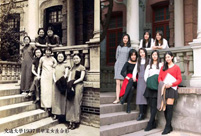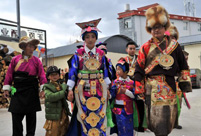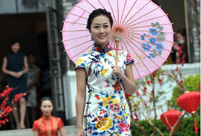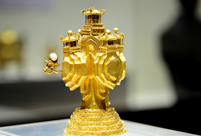


South African pupils mastered the art of Chinese paper cutting in Chinese class.(Picture: Confucius Classroom).
The year 2015 was the Year of China in SA as part of the bilateral agreements for the promotion of trade and people to people exchange between the two nations. In order to promote the mutual understanding between SA and China as well as strengthen the bilateral trade, on March 20 2015 the Department of Basic Education approved the listing of the Chinese language to the school curriculum, as a subject choice for pupils in grades 4 to 9 as a non-official language. Other language choices in the same category include German, Serbian, Italian, Latin, Portuguese, Spanish, Tamil, Telegu and Urdu.
It is not surprising therefore that, from time to time, you hear a friendly South African saying “Ni Hao” to a Chinese person as they walk about in the street, shopping mall or even on a golf course. Although Chinese people can some- times be introverted, on hearing the greeting in their home language they always smile, yet more proof of language being the most convenient instrument to close the distance between two cultures.
South Africans are full of curiosity and love for the Chinese language. Using myself as an example, I was asked to show the Pin Yin input method — the Chinese input method on the computer — by my lecturer at school.
I know of one kindergarten in Johannesburg that is teaching toddlers to say “Kiss Kiss” in Chinese. I know of many of my South African friends who keep Chinese ink and brushes for their Chinese calligraphy practice at home.
While some might speak Chinese only as a hobby, for others it is also a valuable language skill in the job market. There are more than 100 Chinese enterprises within the South Africa-China Economy and Trade Association that are actively looking for local multilingual talent in SA and even more across the Africa continent, where there are more 2,500 Chinese companies.
Mandarin has been instituted at a select number of schools this year as per the programme of the Department of Basic Education. The Confucius Classroom at the Chinese Culture and International Education Exchange Centre in Pretoria is undertaking the teaching task. The Chinese Centre, established in 2012 as an education institution affiliated with the Confucius Institute Headquarters (Hanban), is committed to providing Chinese language and cultural teaching resources and services in SA.
There are four other Confucius institutes — at the University of Johannesburg, the University of Cape Town, Durban University of Technology as well as Rhodes University.
The Confucius classrooms are for elementary and middle schools while the Confucius institutes are for universities.
As of December 1 2015, there are 23 Confucius classrooms and 46 Confucius institutes across Africa, according to official data.
Some schools already had Chinese courses in Gauteng as part of a pilot project.
“Learners are showing great enthusiasm in Chinese classes,” says Evelyn Song Peters, the course coordinator who is also teaching at Pretoria High School for Girls. She says “some learners voluntarily teach, or more likely show off, Chinese to classmates during school breaks”. Peters even has three teachers in her Chinese class.
In 2015, more than 300 South African learners from Gauteng participated in the China in My Eyes Essay Contest, which was co-hosted by the Gauteng Department of Education and the Chinese Centre as part of the “Year of China” celebration. Peters’ students performed the Jasmine Flower Song at the awards ceremony.
While not all of the participants had visited China before, most came up with their story ideas through reading and observation. In the eyes of these learners in SA, China is beautiful, a country of ceremonies and tradition. Added to this is the fact that the Chinese people sup- ported SA’s anti-apartheid struggle from the beginning.
Some expressed their eagerness to visit China in the near future. They have written about China’s history and folklore stories; some introduced China’s economic development; some observed that China is a vast country of 1.3-billion people, 56 ethnic groups and with more than 5,000 years of history.
The learners also wrote about the 12 Chinese zodiac signs in China, the meaning of the colour “red” in the Chinese culture and why the number “8” symbolised wealth, the delicious Chinese food, eating with tricky chopsticks, and the fearsome martial arts.
One of the contestants wrote: “Should I ever have had to fight against the Chinese, I wouldn’t have stood any chance because they can strike with their breaths.”
Dr Lu Zhilei from the Chinese Centre believed that learners from the schools in which Chinese were taught achieved excellent results in the contest. Peters had one student who had won first prize from the Pretoria High School for Girls.
According to the Basic Education Department’s Chinese teaching plan in 2016, there will be 15 schools in Gauteng officially offering Chinese as a subject of choice. The teaching materials will also be uploaded to the Gauteng E-learning platform at the same time, for the convenience of the learners.
“There were schools in SA that were offering this language as an option and what we are saying now is that all schools that do so, should do so, with the necessary resources,” Department of Basic Education spokesperson Elija Mhlanga was quoted as saying when he announced that Mandarin was to be offered in South African government schools.
By 2019, this country will have 100 primary and secondary schools offering Chinese lessons. This means an increased demand for teachers. For this reason, the Chinese Centre plans to train local people, especially those who have acquired teaching degrees from China, to teach Chinese. Both of the language classes and the training for the teachers are free of charge, said Dr. Lu.
To meet the language and acculturation demands from South African civil servants, especially diplomats, the Chinese Centre has also helped the Department of International Relations and Cooperation (Dirco) with its Mandarin training courses for official communication purposes as part of the memorandum of cooperation signed in June 2015.
It has been noted that, as bilateral exchanges between the two countries increase, the demand for Chinese language training is grow- ing rapidly.
Before Dirco, the Chinese Centre also provided faculty assistance for Mandarin training for the Department of Trade and Industry and the Department of Agriculture, Forestry and Fisheries.
The Chinese Centre also carried out the training programme for the Chinese ICT giant Huawei South Africa in 2015. SizweZuma, the pri- vate consultant to President Jacob Zuma and the chairman of the national Insika Foundation, attend- ed the opening ceremony of the training programme at the Huawei Woodmead training centre.
Since June 2015, the Chinese Centre has offered 60 to 240 hours of language lessons for each of the local employees in Huawei South Africa, including Mandarin train- ing, culture orientation and cross- culture communication ability training.
Peters, the lecturer of the course, says that now that there are more employees who understand the Chinese values and Huawei’s corporate culture, the miscommunication within the company has been mitigated.
SizweZuma said that from the head of the state to ordinary people, SA held profound feelings toward China and the Chinese people. He hoped in the future there would be more people-to-people exchanges and cultural activities for the service of the local people.
(The story was originally published on Business Day on January 29th, 2016.)
 Thai most beautiful transgender Nong Poy release new photos
Thai most beautiful transgender Nong Poy release new photos Now and then photos of Shanghai Jiaotong University
Now and then photos of Shanghai Jiaotong University Is this what air travel will look like in 2050?
Is this what air travel will look like in 2050? Aerial view of watermelon terraces in S China's Baise
Aerial view of watermelon terraces in S China's Baise Traditional wedding of a post-80s Tibetan couple
Traditional wedding of a post-80s Tibetan couple Models in cheongsams present classical oriental beauty
Models in cheongsams present classical oriental beauty Second commissioned C28A corvette made by China enters Algerian Navy
Second commissioned C28A corvette made by China enters Algerian Navy Intoxicating Wuyuan in spring
Intoxicating Wuyuan in spring Gold and silver wares of Qing Dynasty exhibited in Shenyang Imperial Palace
Gold and silver wares of Qing Dynasty exhibited in Shenyang Imperial Palace Top 20 hottest women in the world in 2014
Top 20 hottest women in the world in 2014 Top 10 hardest languages to learn
Top 10 hardest languages to learn 10 Chinese female stars with most beautiful faces
10 Chinese female stars with most beautiful faces China’s Top 10 Unique Bridges, Highways and Roads
China’s Top 10 Unique Bridges, Highways and Roads Foreign investors to gain more access to China: minister
Foreign investors to gain more access to China: minister After two-child policy, sperm banks struggle to collect enough donations
After two-child policy, sperm banks struggle to collect enough donations Textbook piracy crackdown unlikely to work, greater awareness needed: experts
Textbook piracy crackdown unlikely to work, greater awareness needed: experts Overseas forces feed on disappearance cases to hype their rhetoric
Overseas forces feed on disappearance cases to hype their rhetoricDay|Week